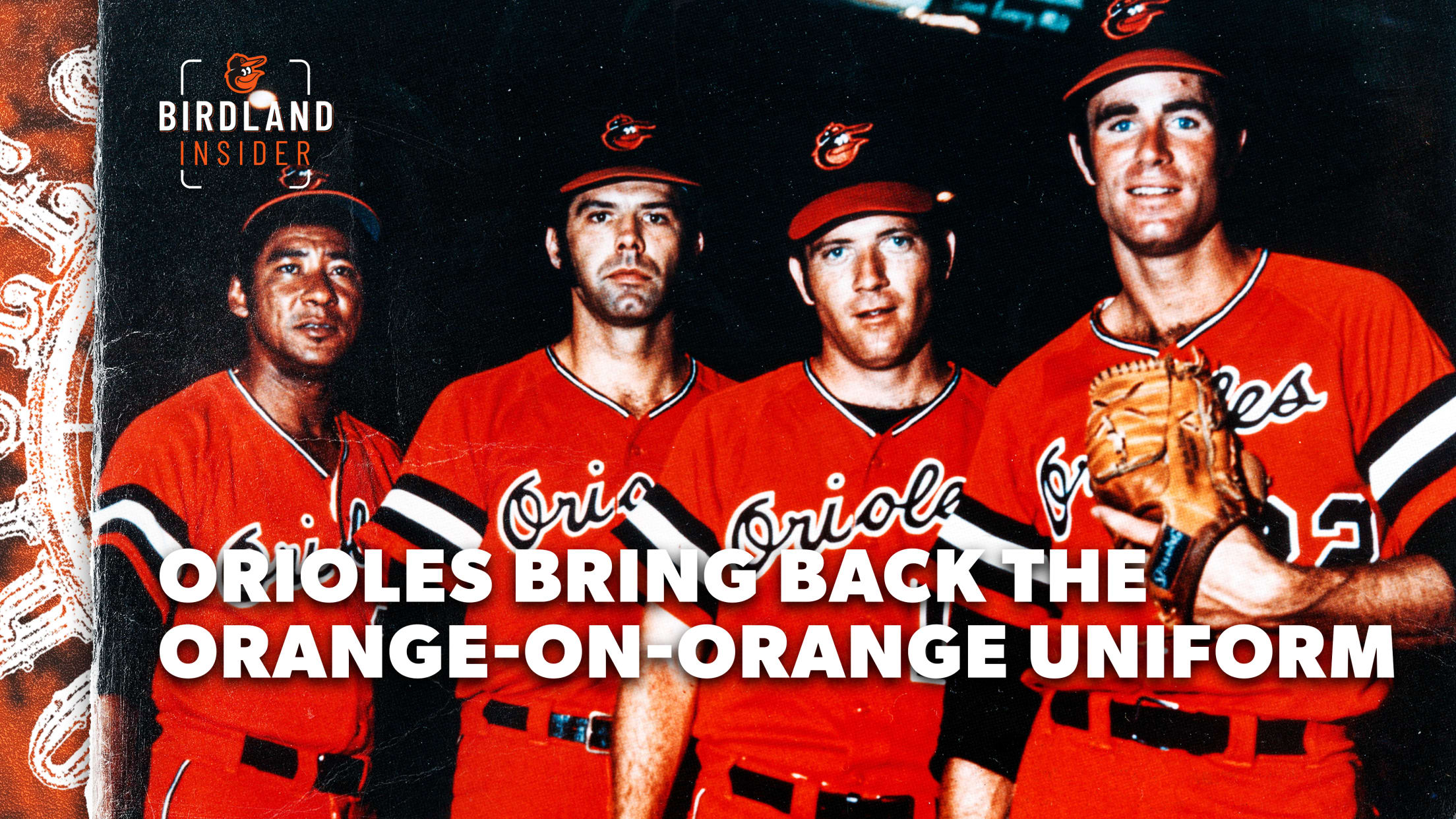
Orioles Bring Back The Orange-On-Orange Uniform?
On Saturday, April 12, the Orioles will debut their newest alternate uniform, an orange jersey and pants set that trace back more than a half-century.
In September 1971, the Orioles became one of the first teams to wear something other than the traditional home white or road gray jersey when they introduced the all-orange uniform.
The uniforms were a product of the ’70s, when baseball teams began introducing bold and bright colors, made possible by the introduction of polyester in the uniform creation process. The 1971-72 Orioles orange “double-knit” uniforms used traditional uniform construction, with button-front jerseys, and the pants had belt loops.
The jersey featured five-inch Powers Style black numbers outlined in white on the front and eight-inch black-on-white numbers on the back, with sleeves trimmed in one-inch black-white-black-orange. The pants had black/white/black trim down the outer seems. Black stirrup socks were worn with the uniform.
There was no advance notice of the new uniform. It was not made public until the Orioles distributed their pre-game press notes before from the first game they were worn, September 16, 1971:
“New Unforms: The Orioles tonight are wearing new stretch uniforms in their colors of orange and black…The Orioles are the first to wear the new double-knit material in their team colors, although other clubs have worn uniforms of different hues in the past…The New York Giants wore all-black uniforms back around the turn of the century and more recently the Chicago Cubs (baby blue), Oakland A’s (green and yellow) and Chicago White Sox (pale blue) have worn other than the traditional gray or white.
It is not contemplated that these uniforms will replace the grays or whites but will be worn for variety both at home and on the road – perhaps once during a series.”
The uniforms drew mixed reactions, even from the players.
“I’m going to stay here (in the clubhouse) until the last minute,” said first baseman Boog Powell.
I think a lot of people will like them when they get used to them.
Outfielder Curt Motton
“I’m just glad to have one in my locker,” said reserve outfielder Tom Shopay, who shuttled between the majors and minors that season.
“That’s right,” fellow outfielder Merv Rettenmund chimed in. “There are a lot of guys in Rochester and Dallas-Fort Worth (home of the Orioles top two minor league teams) who’d like to be wearing this orange.”
“I just wish that the guys who ordered these would have to wear them,” pitcher Dave McNally said.
Actually, one of them did: third baseman Brooks Robinson.
It was Robinson who introduced the idea of the orange uniforms to Jack Dunn III, the Orioles vice president of business affairs, before the ’71 season. The Orioles front office studied sample materials for several months, finally placing an order in August.
The company from which they bought the uniforms? Brooks Robinson Sporting Goods, a local store owned by the Orioles third baseman, who ordered them for the club from Powers Manufacturing a sport apparel company based in Waterloo, Iowa. The tag inside the uniform neck even said “Brooks Robinson Sporting Goods, Baltimore, MD.”
Dunn described the color as “Sienna Orange.” The Orioles script was called “Power Varsity,” a mash-up of the manufacturing company and the more commonly known Varsity font.
The uniforms made their debut on September 16, 1971, in a game against the Yankees at Memorial Stadium. Fewer than 12,000 fans were there to bear witness.
Brooks must have liked the new look; his eighth-inning grand slam gave the Orioles a 6-2 win.
Brooks must have liked the new look; his eighth-inning grand slam gave the Orioles a 6-2 win.
After the game, Dunn, a well-known punster and grandson of the man who signed Babe Ruth for the minor league Orioles in 1914, beamed.
“Orange you glad you’re an Orioles fan?,” he jested.
The Orioles wore the full orange uniforms only two more times that September and a couple times in early 1972 before retiring them.
Perhaps no one was happier than the 6-foot-4, 260-pound Powell.
“I look like a giant pumpkin in these things,” he said.
Three years later, after being traded to Cleveland, Powell was forced to wear the Indians’ all-red jerseys. “Great, now I look like a giant tomato,” he said then.
The Orioles did revive the orange jersey – with standard white or gray pants – in 1975 and would wear it as an alternate most years until 1993, when they switched to black jerseys. The orange jersey returned as an alternate in 2012.
The Orioles’ all-orange jersey made a one-day comeback in 2010 when the Tampa Bay Rays hosted a Turn Back the Clock game on August 13. The Rays, who joined the majors as an expansion team in 1998, wore uniforms of the 1971 St. Petersburg Pelicans.
The throwback jerseys were a near replica, with a belt and black socks, sorry, stirrups were out of style.
That was the last time they would wear them – until this season.
Orange you glad you’re an Orioles fan?
Jack Dunn III
The new all-orange jerseys, which Nike calls “Orioles Orange” and which replicate the current font and numbering, will be worn for select home games during the 2025 season starting with the April 12 game.
The first 15,000 fans attending that 4:05 p.m. game against Toronto will receive an orange Cedric Mullins T-shirt. To purchase tickets, visit Orioles.com/tickets.